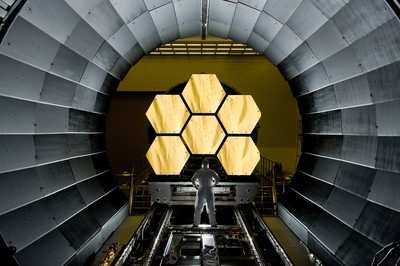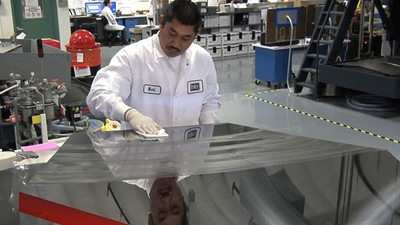Tue, Jul 05, 2011
Accuracies Of Less Than One-Millionth Of An Inch Required
Mirrors are a critical part of a telescope. The quality is
crucial, so completion of mirror polishing represents a major
milestone. All of the mirrors that will fly aboard NASA's James
Webb Space Telescope have been polished so the observatory can see
objects as far away as the first galaxies in the universe.

The Webb telescope is comprised of four types of mirrors. The
primary one has an area of approximately 29.9 square yards, which
will enable scientists to capture light from faint, distant objects
in the universe faster than any previous space observatory. The
mirrors are made of Beryllium and will work together to relay
images of the sky to the telescope's science cameras. "Webb's
mirror polishing always was considered the most challenging and
important technological milestone in the manufacture of the
telescope, so this is a hugely significant accomplishment," said
Lee Feinberg, Webb Optical Telescope manager at NASA's Goddard
Space Flight Center in Greenbelt, MD.

The mirrors were polished at the L3 Integrated Optical Systems -
Tinsley in Richmond, CA. to accuracies of less than one millionth
of an inch. That accuracy is important for forming the sharpest
images when the mirrors cool to -400 degrees F (-240 degrees C) in
the cold of space. "The completion of the mirror polishing shows
that the strategy of doing the hardest things first has really paid
off," said Nobel Prize Winner John C. Mather, Webb's senior project
scientist at Goddard. "Some astronomers doubted we could make these
mirrors."
After polishing, the mirrors are being coated with a
microscopically thin layer of gold to enable them to efficiently
reflect infrared light.

NASA has completed coating 13 of 18 primary mirror segments and
will complete the rest by early next year. The 18 segments fit
together to make one large mirror 21.3 feet across. "This milestone
is the culmination of a decade-long process," said Scott
Willoughby, vice president and Webb Telescope Program manager for
Northrop Grumman Aerospace Systems. "We had to invent an entire new
mirror technology to give Webb the ability to see back in
time."
More News
Airport Marking Aids Markings used on runway and taxiway surfaces to identify a specific runway, a runway threshold, a centerline, a hold line, etc. A runway should be marked in ac>[...]
"It is extremely difficult, if not impossible, for manned aircraft to see a drone while conducting crop-enhancing and other aerial applications at low altitudes and high speeds. We>[...]
Aero Linx: The Skyhawk Association The Skyhawk Association is a non-profit organization founded by former Skyhawk Pilots which is open to anyone with an affinity for the A-4 Skyhaw>[...]
“The T-54A benefits from an active Beechcraft King Air assembly line in Wichita, Kansas, where all required METS avionics and interior modifications are installed on the line>[...]
Aero Linx: Aerostar Owners Association The Association offers the Aerostar Owner a unique opportunity to tap an invaluable source of information concerning the care and feeding of >[...]
 ANN's Daily Aero-Term (04.28.24): Airport Marking Aids
ANN's Daily Aero-Term (04.28.24): Airport Marking Aids Aero-News: Quote of the Day (04.28.24)
Aero-News: Quote of the Day (04.28.24) ANN's Daily Aero-Linx (04.28.24)
ANN's Daily Aero-Linx (04.28.24) Aero-News: Quote of the Day (04.29.24)
Aero-News: Quote of the Day (04.29.24) ANN's Daily Aero-Linx (04.29.24)
ANN's Daily Aero-Linx (04.29.24)





